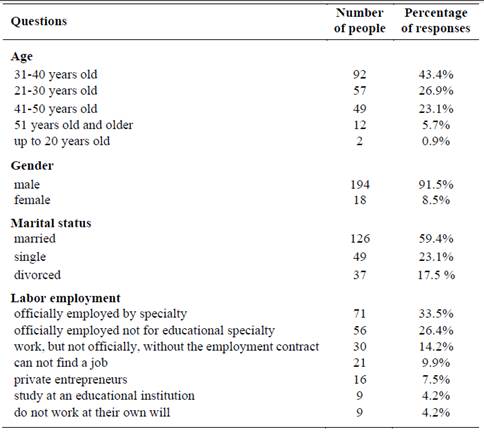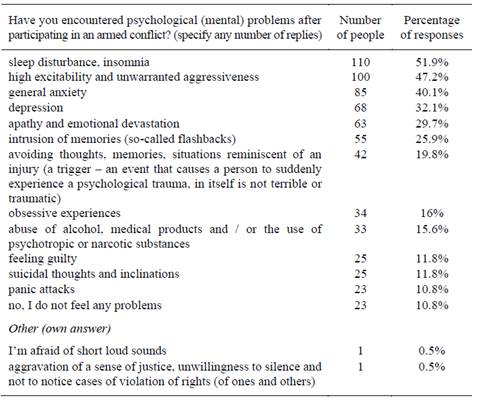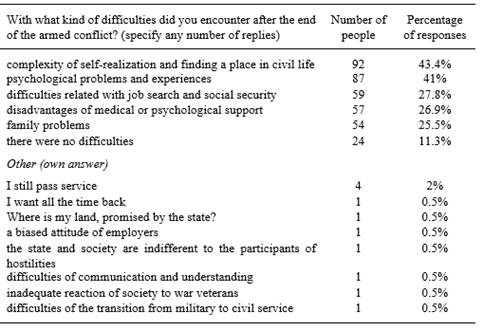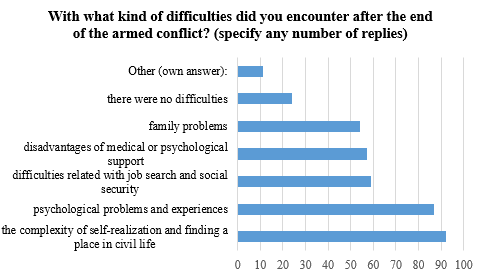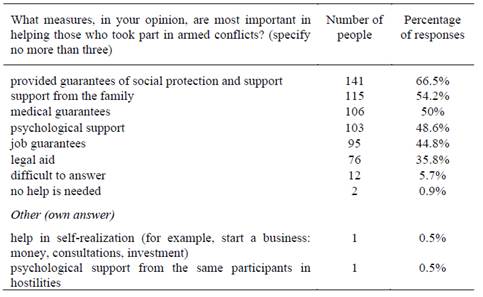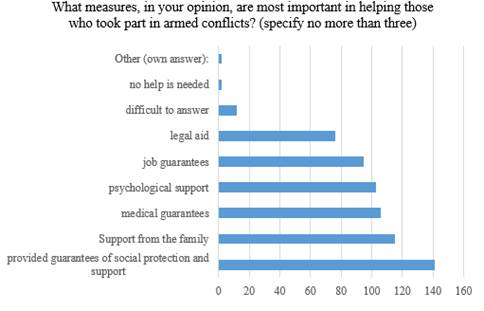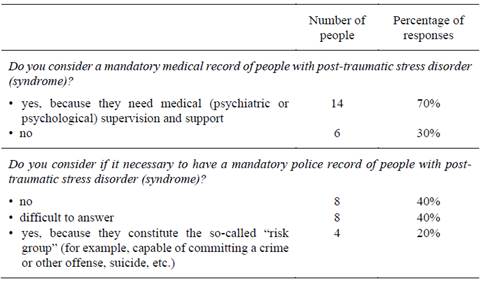I. Introduction
In connection with the increase of the number of international and local armed conflicts and the corresponding growth the number of veterans in the second half of the XX century, the study of mental disorders that arose as a result of participation in hostilities and the impact of other extraordinary stressful situations: disasters, natural disasters, etc., were actualized (Stone, 1993; Tarabrina & Lazebnaya, 1992; Dagan, Zinger & Lavie, 1997; Henning & Frueh, 1998). Such disorders in psychiatric practice have been termed as Posttraumatic stress disorder (hereinafter “PTSD”).
The guarantees of civil rights and freedoms of combats in Ukraine are enshrined in the Constitution and guaranteed by the state, which allow them to choose the type of their behavior, to use the benefits provided to meet their personal and public needs and interests of persons undergoing military service. They regulate the important vital links between the military and the state.
The civil rights of servicemen stipulated by the Constitution of Ukraine (1996) include the inalienable right to life (article 27), the right to respect for human dignity (article 28), the right to liberty and security (article 29), the right to privacy, correspondence, telephone, telegraph and other correspondence, the right to non-interference with privacy and family life (articles 30, 31, 32), the right to freedom of movement, the freedom to choose a place of residence, the right to freely leave the territory of Ukraine (article 33), the right to freedom of thought and expression, to express their views freely beliefs, the right to freedom of thought and religion (article 34, 35), and others. It is important to pay attention to the provision of articles 42, 43, 46 of the Constitution, which enshrines the human right to employment and social protection. All of the above is guaranteed by the Constitution. However, do military personnel have the opportunity to exercise and exercise the rights granted by the Constitution of Ukraine?
First of all, it should be noted that as of July 1, 2019, 369,451 persons participated in the anti-terrorist operation (according to the State Service of Ukraine for Veterans and Anti-Terrorist Participants) received the status of a participant in the anti-terrorist operations in Ukraine (Ukraine State Service for Veterans of War and Participants in Antiterrorist Operations, 2019). I addition, this number is constantly increasing, but already for today, it is almost 0.9% of the country’s population, including children and the elderly.
Thus, among them:
from the Ministry of Defense: 251,568 people.
Ministry of the Interior: 32,589 people.
National Guard: 34,998 people.
Security Service of Ukraine: 11,478 people.
Foreign Intelligence Services: 62 people.
Administration of the State Border Guard Service: 20,641 people.
Administration of the State Special Transport Service: 2,666 people.
Department of state security: 604 people.
Administration of the State Service for Special Communications and Information Protection of Ukraine: 898 people.
State Emergency Service: 5,410 people.
General Prosecutor’s Office of Ukraine: 325 people.
National Police: 6,958 people.
State Fiscal Service of Ukraine: 1,073 people.
Employees of enterprises, institutions, and organizations: 181 people.
So, in general, there are more than 1,6 million war veterans in Ukraine from various conflicts, starting with the Second World War, the war in Afghanistan, etc., which makes up 3.8% of the country’s population (Ponomarenko, 2015).
According to the United Nations Office for the Coordination of Humanitarian Affairs, over 2,540 civilians and 9,000 combats were injured in fighting in eastern Ukraine over 4 years. Unfortunately, the number of dead is increasing every day (2540 civilian men, women and children killed, 9000 injured, 2019).
In connection with the increase of the number of international and local armed conflicts and the corresponding growth of the number of veterans in the second half of the twentieth century, the study of mental disorders that arose as a result of participation in hostilities and the impact of other extraordinary stressful situations: disasters, natural disasters, etc., were actualized. Such disorders in psychiatric practice have been termed Posttraumatic stress disorder.
According to the Ministry of Veterans Affairs of the United States, about 20 veterans of war daily commit suicide (National Veteran Suicide Prevention Annual Report, 2019).
Moreover, as to O. Y. Tretyakov (a Chairman of the Verkhovna Rada Committee on Veterans’ Affairs) more than 1,000 participants in the armed conflict in the Donbas committed suicide after returning from the zone of hostilities (as at the end of April 2018) (Information on the status of a participant in hostilities, 2019). In addition, the International Center of Human Rights «La Strada Ukraine» states that in 2015, the number of appeals with complaints of domestic violence from family members of combats has increased eight-time (Avakov, 2017).
Therefore, it should be considered, that the purpose of the study is to establish and give a criminological analysis of the features of post-traumatic disorders of combatants in the East of Ukraine. As well as to create an algorithm of action that other countries of the world (which have not yet faced with the PTSD problems of combats) can use in the event of a significant negative impact on society because of the actions of persons with PTSD problems of combats. To achieve this goal, it is necessary to solve the following tasks:
- to establish and analyze the social problems with which combats faced after returning from the zone of armed conflict;
- to characterize the main manifestations of post-traumatic stress disorder of participants in hostilities and analyze the main problems of psychological nature that arose after the participation in an armed conflict;
- to identify whether the state provides the necessary level of support for military personnel, which is enshrined in the constitution of Ukraine;
- to conduct an empirical psychometric diagnosis of manifestations of PTSD of participants in hostilities; and,
- to set a number of actions, which should be done by the government to prevent a negative impact on society because of the actions of persons with PTSD problems of combats.
Thus, it should be stated, that the received information should serve as the basis for the organization of social adaptation and rehabilitation of participants in combat operations in the East of Ukraine, as well as for criminological prediction of possible consequences of a criminal nature related with post-traumatic stress disorder in any country of the world.
II. Methodology
Various methods (both theoretical and empirical) of obtaining scientific knowledge have been used to write this scientific study.
First of all, among the theoretical methods, the author used the historical method to establish the development of knowledge about the causes, diagnosis, and manifestations of PTSD. Moreover, the logical method was used to systematize the knowledge about PTSD military personnel and the level of danger they create for themselves and surrounding people.
Besides, the special-legal method was used to study the existing legal framework in the country to create favorable conditions for the rehabilitation of military personnel. In addition to the above methods, a prediction method is used to identify the most effective ways to re-socialize military personnel.
To write this scientific article, various empirical methods have been used to obtain scientific knowledge about the characteristics of PTSD among combats. The main methods of this scientific research were expert interviewing method, interviewing method, psychological testing method, the method of content analysis, and the method of statistical analysis. Thus, the method of psychological testing was used for an anonymous survey of military personnel from eastern Ukraine. Moreover, the method of statistical analysis was used to assess the results of a survey of military personnel returning from the Donbas region. Furthermore, the content analysis method allowed an author to identify the problems that the former military faces in the process of re-socialization, as well as to identify gaps in the work of state bodies in ensuring the proper enforcement of human rights enshrined in the country’s constitution.
Moreover, the main findings of the study are based on a complex of multi-sectoral empirical data: (i) an anonymous survey of 212 participants in the fighting in the East of Ukraine: 194 men and 18 women of different age groups, who live in different administrative-territorial units of Ukraine, namely, Vinnytsia, Dnipropetrovsk, Donetsk, Zaporizhzhya, Ivano-Frankivsk, Lugansk, Lviv, Mykolaiv, Odesa, Rivne, Kherson, Cherkasy regions, and Kyiv. Thus, the data obtained indicate the representativeness of the study (in the questionnaire 1). The data were obtained via an Internet-questionnaire;
(ii) the results of an expert survey of 20 psychologists, psychiatrists, doctors and other specialists in the field of post-traumatic disorders, among whom, include 1 pastor-chaplain and 2 practicing Ukrainian psychologists working in the USA. Moreover, the main age group consists of individuals aged 31 - over 51 (65%). In addition, 40% of specialists have professional experience of more than 10 years. Therefore, all participants in the expert questionnaire (100%) know about post-traumatic stress disorder and had the experience of practical work with their carriers (in the questionnaire 2). The data were obtained via an Internet-questionnaire;
(iii) the results of the PTSD psychometric diagnosis according to the Missile Scale for Combat-Related PTSD for the evaluation of post-traumatic reactions of 11 people participating in combat operations. The data were collected via an Internet-questionnaire; and,
(iv) an interview with a participant in a military operation conducted in the form of an oral interview for 1 hour (it was agreed to use the statement he said in the article subject to anonymity, so the name and other personal data will not be indicated, hereinafter refers to “M.”). The information was collected in Odesa.
The research was conducted from November 2017 to April 2019.
III. Analysis of recent research
The historical beginning of the doctrines of traumatic neuroses is considered to be the nineteenth century: in England and America (1829), in Germany (1840). In 1867, the English surgeon, Erichsen, described mental disorders of the victims of railway accidents (Khrustalyova, 2014, p. 10). Subsequently, various aspects of mental disorders against the background of crisis and extreme situations were studied by foreign scholars such as Bremner, Southwick, Darnell, and Charney (1996).
Furthermore, the features of the post-traumatic reactions of combatants are covered in the works of Marta Elliott, Carlene Gonzalez, and Barbara Larsen (2011); Cathy Spatz Widom (2014); William B. Brown (2011); Aprilakis (2005); and, Begic (2001).
In addition, the post-traumatic stress disorder in the field of criminology and criminal justice was studied by Kris R. Henning and B. Christopher Frueh (1998); Karlijn F. Kuijpers, Leontien M. van der Knaap, and Frans Willem Winkel (2012); Evan R. Seamone (2011); Michael D. White, Philip Mulvey, Andrew M. Fox, and David Choate (2011); Alan A. Stone (1993); Hafemeister, T. L., and Stockey, N. A. (2010).
Moreover, the medical aspects of post-traumatic stress disorder was studied by Edward B. Blanchard, Jacqueline Jones-Alexander, Todd C. Buckley, and Catherine A. Forneris (1996); Yaron Dagan, Yaffa Zinger, and Peretz Lavie (1997); Patcho N. Santiago, Robert J. Ursano, Christine L. Gray, Robert S. Pynoos, David Spiegel, Roberto Lewis-Fernandez, Matthew J. Friedman, and Carol S. Fullerton (2013); Rosellini, Liu, Petukhova, Sampson, Aguilar-Gaxiola, Alonso, Borges, Bruffaerts, Bromet, Girolamo, Jonge, Fayyad, Florescu, Gureje, Haro, Hinkov, Karam, Kawakami, Koenen, Lee, Lépine, Levinson, Navarro-Mateu, Oladeji, O’Neill, Pennell, Piazza, Posada-Villa, Scott, Stein, Torres, Viana, Zaslavsky, and Kessler (2018); Waddington, Ampelas, Mauriac, Bronchard, Zeltner, and Mallat (2003); Tarabrina and Lazebnaya (1992). Moreover, the psychological rehabilitation of soldiers with post-stress mental disorders are covered in the works of Aleschenko and Hmilyar (2015).
IV. The theoretical basis of the study
The civil rights of combats are natural, fundamental, inalienable human rights that have, in the main, a negative right, that is, rights that are protected against any interference, including state, in the exercise of civil rights. These rights, as natural rights, form the basis of the legal status of a person. Civil rights are usually attributed to the capabilities of a person necessary to ensure his or her physical and moral-psychological (spiritual) personality.
First of all, it should be noted, that Posttraumatic stress disorder is defined by the American Psychiatric Association in the Diagnostic and Statistical Manual of Mental Disorders as a severe a mental condition that occurs as a result of a single or repeated psycho-traumatic situations, such as participation in hostilities, severe physical injury, sexual abuse, or the threat of death (American Psychiatric Association, 2013).
In addition, PTSD in scientific literature is considered as a complex problem, the negative consequences of which are studied in the context of psychology, psychiatry, medicine in general, sociology, criminology, and criminal justice.
Thus, Post-traumatic stress disorder of veterans of the wars is an actual criminological problem. It should be emphasized that the criminological study of post-traumatic conditions is not limited only to the study of crimes committed by persons from the PTSD, but refers to all deviant activity in general (for example, alcoholism, suicidal behavior, etc.).
The number of war veterans in the criminal justice system is steadily growing. According to the statistics, in the United States, about 9% of the total number of prisoners are war veterans. At the moment, this is quite high, as 7% of the population are veterans of the wars (approximately 300,000 veterans who participated in the armed conflicts in Iraq and Afghanistan and who were diagnosed with PTSD).
Among the deviant signs observed among participants in armed conflicts, it can be noted: mistrust of other people; inability to talk about war; the loss of meaning in life; lack of self-confidence; inability to be open in communication with others; anxiety; the need to have weapons; rejection of veterans of other wars; negative attitude towards the authorities; the desire to remove anger because he was sent to war and for everything that happened there; and, the need to participate in dangerous «adventures» (Zelenova, 2005, p. 91).
PTSD manifests itself in the form of a reproduction of a psycho-traumatic event in the mind. All this leads to conflicts, outbursts of anger, aggression, the abuse of alcohol and drugs.
Since its debut in the psychiatric nomenclature in 1980, PTSD has had a tremendous impact on criminal jurisprudence. In criminal proceedings, an accused can use this disorder as a factor to exclude guilt or mitigate punishment. PTSD is recognized as a mental illness, the accused are not responsible for their actions. As the jurisprudence has developed, the confession of the guilty person with PTSD mitigates the punishment, namely: this person does not apply such punishment as deprivation of liberty, and in most cases, compulsory measures of treatment are applied. Moreover, the accused can use PTSD as a factor of excluding guilt or mitigating punishment, not only for violent but also for non-violent crimes (Stone, 1993).
To correct the problem of increasing the number of veterans of the war with PTSD in the criminal justice system, it should be noted that the use of compulsory treatment should not be carried out only after committing a socially dangerous act when a person suffering from PTSD is already involved in the criminal justice system. Early intervention, before developing symptoms of this disorder under adverse conditions, would serve as a preventive factor in preventing this disease. To solve this problem, additional research will be needed, namely: to determine personal, social and professional factors that increase resistance to PTSD (Stone, 1993, p. 9).
For example, upon completion of military service, programs aimed at the full reintegration of a war veteran into civilian life will allow early detection of PTSD and associated disorders, to start treatment from an earlier period. Finally, the decisions of the courts aimed at applying coercive different measures of treatment of this mental state of the individual will provide another level of protection of society from persons suffering from PTSD.
V. Socio-demographic characteristics of the study participants
It should be stated that the structure of the questionnaire anonymous survey for participants in armed conflicts included three thematic blocks: (i) the first one is personal data; (ii) the second block is the psychological block of questions (these questions were related to the psychological feelings of the participants); and, (iii) the third block is the social block (these questions were related to the social adaptation of people who returned to civilian life).
Thus, the questionnaire consists of 11 questions, which should facilitate the convenience and speed of the answer and also should lead to a maximum concentration on the content of questions and objectivity of responses.
Persons of all age groups participated in the study: up to 20 years old were 2 persons (0.9% of the total); 21-30 years 57 persons (26.9%); 31-40 years old 92 (43.4%); 41-50 years 49 (23.1%); and 51 years and older 12 people (5.7%). Thus, persons aged from 31 to 40 years made the largest share.
Among the respondents, there were 194 (91.5%) men and 18 (8.5%) women. Family status of the interviewed: married 126 (59.4%) person; single 49 (23.1%); and, divorced 37 (17.5%).
The last question in the questionnaire data of respondents was about employment. So, 9 persons (4.2%) persons study at the educational institution; officially employed in the specialty 71 (33.5%) persons; officially employed not in educational specialty 56 (26.4%); work, but not officially, without the employment contract 30 (14.2%); private entrepreneurs - 15 (8.3%); do not work by their own will 9 (4.2%); and, can not find a job 21 (9.9%) person (Table 1).
VI. Psychological characteristics of combatants: general mental state and post-traumatic problems
The psychological block included three questions. The first question is, “Do you know what PTSD is?” Second question: “Do you need psychological help?” And the last (third question): “Have you ever faced with psychological (mental) problems after participating in an armed conflict?”
Thus, firstly, almost all the combatants who participated in the study knew about PTSD (total is 98.6%, 212 persons). Among them, 44.8% (95 people) knew about PTSD from their own experience or the experience of their relatives and friends. Moreover, only three veterans (1.4%) did not hear about PTSD.
To determine the general psychological state of combatants, it was asked (the second question) about the need for professional help from psychologists or psychiatrists. More than half of respondents (54.2%, 115 people), in their opinion, need such help. Among them, 43.4% of respondents said that they only need help in some cases, 10.8% feel the need for systematic help, 26.9 % of respondents gave a negative answer, and another 18.9% were not identified, indicating that it is difficult for them to respond. How the results for this question can be commented on? Without a thorough analysis, there may be a false opinion that war veterans in the East of Ukraine have no psychological characteristics, since most of them do not feel the need for help or only sometimes experience it (70.3% in total). Indeed, in some cases, such professional help from psychologists may require anyone from adolescents to retired. Thus, 10.8% feel the need for systematic assistance from psychologists or psychiatrists is almost every tenth of the respondents. 18.9% were difficult to answer, they could not clearly say “no” to the question. Probably, 18.9% of respondents may require constant qualified help from psychologists. In sum, this is 29.7% or almost every third. Besides, another 43.4% sometimes need help, and this one in two, who in some cases needs professional help.
Summarizing the main clinical symptoms and manifestations of post-traumatic stress disorder, provided in the specialized literature, and obtained from an expert survey of psychologists, psychiatrists, and other specialists, it was found which psychological problems appeared in persons after engaging in hostilities (it was the third issue of the psychological block). The following results were obtained (in this question, the respondents were able to indicate any number of responses) (Table 2).
Thus, according to the data obtained from the third question, the vast majority of veterans of the war (89.4%) faced various mental problems after participating in an armed conflict. It should be noted that most often respondents indicated: sleep disorder; high excitability and unwarranted aggressiveness; general anxiety; depression; apathy and emotional devastation and invasion of memories (so-called flash-bucks) etc.
At the same time, the most socially significant and dangerous (or those that have a criminal potential in the form of a possible implementation of deviant behavior) are violations such as high excitability and unwarranted aggression, which was indicated by almost half of the participants in the hostilities (47.2%, that is almost one in two); abuse of alcohol, medical products and/or the use of psychotropic or narcotic substances (15.6%); suicidal thoughts (11.8%, that is, almost one in eight). Such symptoms in certain life circumstances can cause aggressive behavior to themselves (direct aggression in the form of suicide or the form of alcoholism, drug addiction, etc.) and to some close persons (for example, members of the family, neighbors, etc.) or other persons.
M., a participant of military actions, during the interview accentuated our attention to the following problems of psychological nature, which are the result of the experienced “horrors of war”:
«The traumatic human psyche is the result of hostilities-death, injuries, cold, deterioration of living conditions, various types of crimes (…). All these factors are causes (mental) injuries of veterans. Especially when you see it all with your own eyes. Hence the consequences: alcoholism, criminogenicity, suicide, drug addiction» (interview with M., participant in military operations).
VII. Social status of combatants: problems and guarantees of ensuring basic human rights
It should be identified, that the social block of questions is devoted to the study of the social status of veterans of the war and to the identification of possible problems with which they encountered after the end of their participation in hostilities.
Thus, it was proposed to evaluate the assistance and support of the state for those involved in armed conflicts (the first question of the social block). The vast majority of respondents (80.2%) indicated that the assistance was inadequate and rather declarative. Only 4.7% of respondents considered support and support sufficient until 15.1% were unable to answer.
At the same time, 78.8% of respondents consider that it is important to cooperate with state bodies and volunteer organizations in assisting those who participated in armed conflicts, 7.5% consider such cooperation inappropriate because the state has enough resources and legal mechanisms of assistance, 13.7% have not decided on this (second question of the social bloc).
To analyze the main problems that are worrying war veterans in the East of Ukraine, the question was raised about the difficulties they encountered after the end of their involvement in the armed conflict (the third issue of the social block). Respondents were able to specify any number of responses and provide their options (Table 3).
So, as can be seen from the results obtained, staying in the area of hostilities has a significant negative impact on individuals. Thus, only 11.3 % of respondents indicated that they did not have any difficulty after the end of the armed conflict. Moreover, 43.4 % of war veterans pointed to the difficulty of self-realization and finding their place in civilian life; plus the following respondents’ answers: “difficulties of the transition from military to civil service” (0.5 %), “state and society indifferent to combatants” (0.5 %), “inadequate social reaction to war veterans” (0.5 %). Additionally, 41% of the responded combatants pointed to psychological problems and experiences, and here it is possible to add “difficulties of communication and mutual understanding” (0.5 %), and, in our opinion, the answer “I want all the time back” (0.5 %). One-fourth of respondents (27.8 %) indicated difficulties with job search and social security. Some respondents specified social security problems with their examples of life: one respondent (0.5%) drew attention to the “biased attitude of employers,” another one asks “where is my promised land?” A little less (26.9 %) of the interviewed participants in the armed conflict drew attention to the disadvantages of medical or psychological support, even though the corresponding benefits are guaranteed by the current legislation of Ukraine. A quarter of respondents (25.5 %) among the difficulties that arose after the end of the armed conflict, pointed to problems in the family. Such a situation can not but attract attention, because, in this context, the family is not just a community, but an important link in the rehabilitation of veterans of the war. According to other studies, often family members of people with post-traumatic illness suffer from domestic violence, which becomes the basis for the complication of relationships or the collapse of families.
During the interview, M. stated that the main problems arise because of the lack of understanding of relatives and surrounding ones. The veteran can divide the participants into their “own” and “civilian”. He is unlikely will tell the civilian about his experiences he experienced in the war. There is a big difference between the civilian surrounding environment and military life. The first thing that cuts your eyes: how can you live here when we are there? But then life goes on. The problems of misunderstanding with civilians are their considerations, their vision of their truth. Someone has said, someone has heard, “the war of the oligarchs” etc. The civilian often does not understand the cause-effect link of the war.
He added that the first issue is that I would have called misunderstandings of veterans with civilians due to subjective experience. As an example, people burn tons of pyrotechnic products on holidays, which (explosions) are associated with bad moments in the past of war veterans. The second problem is the lack of government programs and mechanisms for realizing the creative potential of the military, in particular, affordable loans for their own business and all other institutional mechanisms. Moreover, the lack of good work that would be paid, where the veteran could feel useful. So, misunderstanding in the family is also one of the most important problems when there is no support for children, mothers or other family members.2
The outcome of the social block became the fourth issue of what measures are most important in helping those who took part in armed conflicts (namely, “What measures, in your opinion, are most important in helping those who took part in armed conflicts?”)? Respondents were able to specify no more than three responses and provide their options (Table 4).
To illustrate the results of the questionnaire on this issue, we present a fragment of an interview with M., a veteran of military operations, who, by his own example, reveals the specific problems with which he has to face life and what kind of help he needs most. M. states that war veterans have a system of legal privileges, but not all of them work, as well as much in our country, but it is still better than nothing. Among the social benefits, the most significant are free seats in metro, intercity, trams, trolleybuses and other municipal transport. Monetization has become an important element in streamlining these privileges, introduced by the government, which conveys broad powers of price regulation, e-ticket and direct compensation of the cost. As a person who has a certificate of a participant in military operations, I pay the cost of traveling in municipal transport, because it is easier for me to pay psychologically than to quarrel or prove something to the municipal transport drivers.
M. added that reducing utility prices (their compensation) is a good privilege for those involved in hostilities. Nevertheless, as for me, I would change all the privileges for state investment programs (support and credit) of their own affairs for participants in hostilities. Such programs will solve a whole series of entire social problems, not only veterans of war but also society3.
VIII. Results of expert psychometric research. Mississippi scale for combat-related ptsd
The expert survey (questionnaire 2) of psychologists, psychiatrists, doctors, and other specialists made it possible to form a clearer picture of post-traumatic stress disorder and those who make up the “risk group” to become its carriers. When asked about the possibility of a complete deprivation of personality of manifestations of post-traumatic stress disorder, 50% of the experts replied that «yes, but in case of proper treatment»; 25% «yes, but only over time» (the longer, the better); and, 25% «no».
According to all interviewed experts (100%), those who participated in armed conflicts need examination and professional psychological, psychiatric and/or medical care: systematically 90%, and in case of an urgent need 10%.
So, as can be seen, the experts were asked questions to find out the need for the registration of persons with post-traumatic stress disorder (Table 5).
To assess the degree of expression of post-traumatic stress reactions in combatants in the East of Ukraine, the Mississippi Scale for Combat-Related PTSD of 1987 was applied. This technique belongs to the group of empirical psychometric measurements of PTSD and in our time is one of the widely used tools for measuring the signs of post-traumatic stress disorder4. The use of the technique has been officially authorized by the United States Department of Veterans Affairs (National Center for PTSD, 2019).
Thus, the psychometric research includes 11 participants of combat operations (10 men and 1 woman) from different regions of Ukraine. As data on the interpretation of the results of the Mississippi Scale, research indicators were selected by Tarabrina (2001) (one of the first in the post-Soviet countries to use this methodology for the study of veterans of the war in Afghanistan). As a red-line for measuring the signs of post-traumatic disorder of soldiers and veterans of war, the results of empirical calculations were selected by Tarabrina: the norm is 70-73 points, PTSD is 92 and more points.
Thus, according to the results of our study, it was found out that (out of 11 participants of anonymous psychodiagnostic) 5 people have the degree of exposure of the traumatic experience significantly exceeds the average indicators of “norms” for veterans of the war, of which 2 people can be suspected of PTSD (Table 6).
The conducted research with the use of various methods and empirical basis made it possible to form conclusions about the main social and psychological problems of veterans of combat operations in Ukraine, the main clinical manifestations (symptoms) of post-traumatic stress disorder and the frequency of their presence in participants in armed conflict, which could become the basis for further scientific searches and criminological forecasting.
According to the results of the research, it has been established that persons who participated in combat operations in the East of Ukraine have a number of psychological and social problems after returning from the conflict zone.
There are many problems of a psychological nature: sleep disturbance and insomnia; high excitability and unwarranted aggressiveness; general anxiety; depression; apathy and emotional devastation; invasion of memories; avoiding thoughts, memories, and situations reminiscent of injury; obsessive experiences; abuse of alcohol, medical products and/or the use of psychotropic or narcotic substances and feeling guilty; suicidal thoughts and inclinations.
Moreover, many veterans of war after engaging in hostilities in the East of Ukraine faced the complexity of self-realization and finding their place in civilian life; employment problems and social security; disadvantages of medical and psychological support; family problems.
“Risk group” is made up of participants in fighting, abusing alcohol, medicines and/or using psychotropic or narcotic substances (15.6%), suicidal thoughts and inclinations (11.8%), and is characterized by high excitability and unjustified aggression (47.2%). The “clash” of these negative symptoms with social problems faced by a significant proportion of veterans after their return from war, frustration, mismatches between “desired” and “real”, “social injustice” and specific life situations can be the cause of prolonged destabilization that will manifest itself in the impossibility of adapting to civil life or even suicide, the commission of criminal and other offenses.
IX. Proposals to minimize the negative effects of ptsd among military veterans
It is considered that in order to minimize the possible negative consequences of participation in hostilities, as well as to establish social policy and support veterans (to ensure the proper performance by the state of its functions, which are enshrined in the Constitution of Ukraine), it is necessary to solve the following problems as soon as possible:
(i) To establish a centralized system of social support for combatants, headed by a central government body. The name and legal status of such an institution are irrelevant: it may be the Ministry of Veterans Affairs, as in the United States, for example, or the State Service of Ukraine for Veterans and Anti-Terrorist Participants, which has been in operation since 2014. The name of the department or its subordination is not what is important. The main thing is that the work is done.
Veterans of war must receive all social benefits and guarantees from one department, and not “separate” between different authorities and services, without understanding the mechanisms for the realization of their legal rights. A specialized central government body should formulate and implement a clear unified state policy on social protection, support, and rehabilitation of war veterans. Assistance to combatants is the responsibility of the state and not the military’s desire.
It is worth saying that the first steps in this direction have already been made. Thus, on November 28, 2019, through the reorganization of the State Veterans Service, the Ministry of Veterans Affairs of Ukraine (2018) was created. According to the Regulation, approved by the Decree of the Cabinet of Ministers of Ukraine of December 27, 2018 No. 1175 (as amended by the Cabinet of Ministers of Ukraine resolution of October 16, 2019, No. 887) for veterans, there are:
a) formation and implementation of state policy in the field of:
- social protection of veterans and their families, including the provision of psychological rehabilitation, social and professional adaptation, employment, increasing competitiveness in the labor market, as well as technical and other means of rehabilitation, sanatorium treatment, housing; provision of educational services, life-long government scholarships, annual payment up to May 5 of one-off financial assistance (except for the organization of payment of such assistance); granting, revocation and certification to veterans;
- maintaining the mental health of veterans and their families;
- honoring the memory of veterans;
- the temporarily occupied territories of Ukraine and the population living there, the ultimate purpose of which is their reintegration into a single constitutional space of Ukraine;
- internally displaced persons from the temporarily occupied territories of Ukraine, facilitating the exercise of their rights and freedoms and creating conditions for the voluntary return of such persons to the abandoned place of residence after the restoration of the constitutional space of Ukraine (reintegration) or integration into the new place of residence in Ukraine;
- application of norms of international humanitarian law in the territory of Ukraine;
- peacebuilding, reconstruction, and development of Donetsk and Luhansk regions;
b) ensuring the rights and freedoms of veterans and their families;
c) ensuring the formation and maintenance of the Unified State Register of War Veterans.
(ii) Organizing and establishing systematic psychological support for combatants should begin from the first day after returning from the zone of armed conflict. This should be a multiplicity of measures aimed at adapting and returning war veterans to civilian life. Rehabilitation centers for psychological support should be functioning with the involvement of highly specialized experts in the field of psychology, doctors, the public, churches and other institutions of civil society. Crisis centers should be created, where veterans will be able to communicate not only with the staff of such institutions but also with each other. Moreover, there should be group training where veterans will be able to share their experiences and problems and solve them together.
(iii) Furthermore, it is necessary to develop a mechanism for the gradation of combatants and accordingly provide a different amount of benefits to such persons. For example: persons who were in places of particularly severe confrontation and intensity of hostilities; and, persons who are on the so-called second-third line of defense. Thus, those who were in the places of hostilities, but not in the intensity of hostilities directly.
(iv) To set up and organize the work of the chaplains on the line of combat collision. Making it systemic, getting involved with state support, and conducting chaplaincy throughout the units of the Armed Forces of Ukraine on the front line of fighting.
X. Conclusions
Thus, as a results of the study of PTSD among military veterans, it can be concluded that:
1. The guarantees of civil rights and freedoms of combats in Ukraine are enshrined in the Constitution of Ukraine and guaranteed by the state.
2. As a medical problem, PTSD is a disease that needs to be treated. As a type of neurosis, PTSD is characterized by the symptoms presented in this study. These manifestations are described in section VI of the article. Over time, clinical manifestations of the disease can be expressed differently, have different intensities of manifestations. If the patient’s clinical picture does not change over time, PTSD can develop into a chronic disease. The solution of the medical side of the problem is possible subject to the observance and implementation of the provisions of Art. 49 of the Constitution of Ukraine, which guarantees the right to health and medical protection of every citizen.
3. The social problem of PTSD is described in detail in section VII of the article. Of particular social importance is PTSD, which is observed in persons who have participated in armed (military) conflicts. Given the prevalence of local and global conflicts, the number of combatants (war veterans) is steadily increasing. At the same time, the number of carriers of this syndrome increases.
In this context, the organization of social protection and support for such persons, psychological support and assistance, medical care and other social guarantees, which are mentioned in section IX of the article, becomes relevant.
4. In the context of the criminological problem, PTSD can be considered as (i) a criminogenic factor (this conclusion is explained by the statistical increase in the number of war veterans in the criminal justice system); (ii) a factor that increases the victimization of a person suffering from PTSD (the likelihood of becoming a victim of crime is increased by the other party to an armed conflict, and the possible development of “social outsider” in such persons; and (iii) a factor of suicidal behavior.
5. PTSD of war veterans is a huge social, medical and criminological problem. Persons, who return from an area of hostilities, need to be involved in civic life. This is a long process of social, psychological and medical work and rehabilitation. If today the relevant work in Ukraine will not be carried out, then tomorrow we will have to deal with large-scale negative social consequences, because the criminal potential of PTSD is more than significant.













